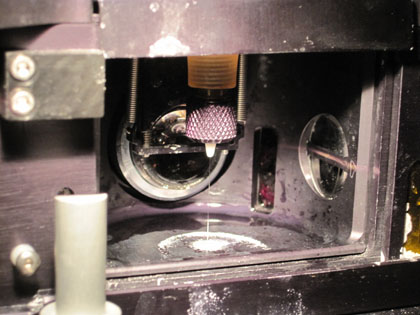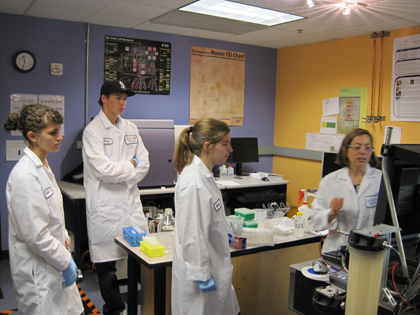
Flow cytometry is a technology used to count the number of microscopic particles, generally cells, in a liquid sample. It can also be used to separate different types of particles based on their charge. It uses a variety of lasers and sensors to determine certain characteristics of the particles as they are counted. Flow cytometry is one of the principal technologies for diagnosing many types of blood disorders or other health conditions but is also extremely useful in research as it provides very precise cell counts for some types of organisms that more traditional technologies such as spectophotometry are unable to measure.
The concept of flow cytometry is relatively simple. A liquid sample is directed through a tiny nozzle which essentially squirts the sample in an extremely thin stream. The stream of liquid is so thin that only one cell can pass through the sensor at a time, making it possible to count the number of cells that pass through the sensor and temporarily block or reflect the path of light pointed at the cells. Once the sample is turned into such a thin stream, several different types of lasers are directed at the liquid. Individual particles reflect different wavelengths of light in different ways and light sensors are able to measure this difference. This information can be used to count and differentiate between different types of particles within the sample. Generally particle counts are done in relation to a known quantity of specific particles that is added to the liquid sample before it is run through a flow cytometer. This process is a very precise way to count the number of cells within a sample, and this is how we used the flow cytometer while at ISB.
We got the opportunity to actually use this piece of equipment to gather data for an experiment we conducted. Monica Orellana showed us how to use the flow cytometer and was very helpful in answering our questions about how the piece of technology actually works. We used the flow cytometer to gather cell counts for our Diatom Lab. This was a long process that included fixing our samples each day for an entire week, adding beads to our samples as a relative particle count for measuring cell counts, making a 9% NaCl Solution that the flow cytometer requires to run, and actually running our samples through the machine. We also got a lot of help from Alexis Valouri-Orton in analyzing our data that came from the cytometer.
For more information on the flow cytometer that we used, visit the product's website.

|



